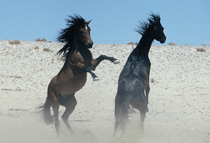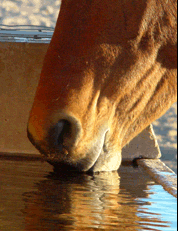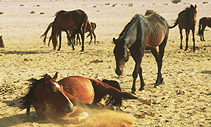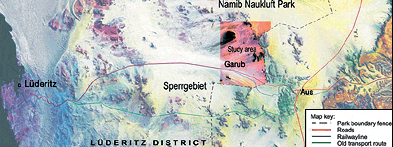| EQUINETOURISM - WORLDWIDE - The Namibia Wild Horses - Wild Horses of the Namib |
| Exploring the Wild Horses of Namibia |
The mysterious origins of the Wild Horses of the Namib are endlessly alluring. These horses have gained the freedom to live according to their own rules, and are able to survive in the harshest conditions in a vast desert. They have rediscovered their natural behaviour and their own social order. Read their amazing story...
|
|
|
A Symbol of Unlimited Freedom
The Wild Horses of the Namib attract thousands of tourists each year. And every so often they cause headlines and relief efforts. Like in 1991/92, or again in 1998/99, when the horses were starving as a result of drought and weaker animals perished. As soon as photos of the emaciated animals are published, the readiness to rush to the rescue is as overwhelming as some humanitarian aid organisations can only dream of. Why is it that the Wild Horses touch people deep down in their hearts? What is it that gets us so enthusiastic about them?

No doubt the mysterious origins of the Wild Horses are part of their allure, but it is not the real issue. Rather, we are fascinated because the horses have gained the freedom to live according to their own rules. They have broken free from their man-given role of stud, show-jumper or hobby-companion. They have rediscovered their natural behaviour and their own social rules. Don't we all dream of liberating ourselves of the constraints of civilisation?
We are also fascinated by the habitat which the horses have chosen: vast desert instead of paddock or stable. We are fascinated because the Wild Horses have conquered an alien world.They have learnt to defy the harsh conditions of their new surroundings and survive. With the difference, however, that they evidently enjoy their 'island'.
Freedom, space, nature – these are the qualities which man has lost as a result of civilisation and for which he yearns from deep within.Freedom, space and nature are also the reason why holiday-makers from Europe come to visit the country year after year. The Wild Horses have something which not only fascinates us, but for which we actually envy them.
But the envy turns into pity as soon as freedom and nature take their toll - that is, when horses starve or even perish during a drought. Man's compulsion to intervene may be an echo of his guilty conscience towards the creature which - in his zealous attempts to take control of Earth - he crammed into reserves and zoos. With regard to the Wild Horses there is another factor: they are often seen as domestic animals for which man feels an added obligation to care. But these horses are no longer domestic. They are part of nature, uncontrolled by man, and as such subject to the rules of nature. The death of weak animals at times of drought is the natural cycle taking its course.
This does not mean that the horses should be left to fend for themselves. But the time has come to replace the myth around the horses with a realistic picture. And to get us to think about whether the skinny horse that we pity isn't happier than the handsome steed in its dark stable.
The Wild Horses of the Namib Desert - Life at Subsistence Level
Every couple of years, when the area on the fringe of the Namib Desert in southern Namibia is hit by a drought, they cause headlines far beyond the country’s borders: the Wild Horses of the Namib.
Relentlessly the sun is beating down on the desolate land. Rocks, rubble, sand. Here and there a shrivelled shrub or a tuft of yellow grass. The heat fills the sweeping valleys with liquid air. Shadows are swimming on the shimmering plain and slowly start to take shape: a stallion and two mares. Step by step they struggle along. It is a long way from their grazing area to the horse-trough. As grass becomes sparser, the distance increases with each day that passes without rain. The last rains must have occurred long ago: the horses’ ribs are sticking out sharply.
The Wild Horses in the area around Garub, 20 km west of Aus, have a tough life. Rainfalls are rare and unreliable - often just enough for succulents, prickly shrubs and grasses. Still, the horses usually find sufficient grazing. But years of drought occur regularly in the fringe area of the Namib Desert. Like in 1991/92, or in 1998/99, when the horses were starving and weaker animals perished. The public outcry in Namibia and far beyond the borders resulted in costly efforts to catch or feed the horses. In both cases success was only moderate.
At the same time an old debate was rekindled: should the horses be tolerated there? After all, a large part of their habitat is situated in the state-owned Namib Naukluft Park, which is supposed to protect the indigenous flora and fauna - and not these 'aliens' which are descended from domesticated horses, have only been in the area for 90 years and would not be able to survive without the watering trough set up at Garub by man (see box 'origin').
Besides, some conservationists feared that the Wild Horses would drive out indigenous plants and animals and therefore wanted to remove them from the park. Due to massive pressure from the public, the media and horse-lovers in the Ministry such plans were dropped, however. Since then the horses have become a tourist attraction and as such generate earnings and jobs for local people.
|

Two stallions fighting - a rare sight


|
Disruptive element in a fragile environment?
The justified concerns, however, were still not eliminated, the problems were far from being solved. The surroundings of Aus are regarded as a 'biological hotspot' – with more than 500 plant species, some of them endemic (which means that they do not occur anywhere else). What if the horses were a disruptive element in their environment and contributed to unique plants becoming extinct? What does the presence of the Wild Horses mean for the management plan of the nature reserve? Can the horses be treated like game and can they simply be abandoned in years of drought? Or should there be any intervention? If so, what form should it take?
Supported by the Ministry for the Environment and Tourism, as well as lodge and tour business Klein-Aus Vista and the Nature Investments company (t/a Gondwana Desert Collection), biologist Telané Greyling has dealt with these and other questions in her thesis. She presented the results of her research to a work meeting which was held at Cañon Village in November 2005 to discuss future steps concerning the Wild Horses. Among the participants were representatives of the Ministry, nature conservation, the veterinary services, tourism and scientists from Namibia, South Africa and Britain.
On the basis of her extensive research the experts first debated the key issue of whether the horses should be seen as aliens in the Namib Desert’s fragile ecosystem. Greyling, however, has not been able to substantiate the claim that the horses displace the indigenous flora or fauna. She stated that by and large the same species and same numbers of individuals which are found in nearby areas of comparison occur also in the area where the horses live.
Sound Management instead of Contingency Aid
In a second step the meeting looked at recommendations, especially tailored to the horses, for a possible management plan to be drawn up by the Ministry. Of course the horses can not be regarded as ordinary game like Gemsbok or Springbok. On the one hand they are no longer domesticated animals but part of the ‘wide’ open and as such subject to nature’s rules. Therefore the death of weak animals in times of drought is the natural cycle taking its course. On the other hand, man can not simply deny all responsibility. Fences block access to natural watering places and better grazing on farms bordering the area to the east (a death-trap for Gemsbok as well, by the way). And in times of drought the number of animals might drop so severely that the gene pool is affected negatively and their survival endangered by inbreeding. Saying yes to the horses also means yes to preservation.
Before considering possible steps, the desired goals have to be clear. The meeting agreed on the following: to ensure a stable population of Wild Horses, to keep the costs for their care as low as possible, to utilise the attraction more efficiently for tourism, to gather more information on the animals and to improve the knowledge of the public.
A prerequisite for controlling the horse population is to monitor rainfall, grazing, the numbers and the condition of the animals on a regular basis. It was agreed that the reference value for a stable population is 130, with short-term fluctuations between 80 and 180. Such fluctuations occurred in the past as well. During the seventies and eighties the number of horses was estimated at 250, but when fences were put up in the late eighties the number dropped considerably. 104 horses were caught in June 1992. There were 110 horses in 1993, in 1997 the number had risen to 149, in 1999 it dropped to just 89, and at present it is back to about 150 animals.
The expert team also recommends to set up a watering place in a neighbouring grazing area in times of drought to shorten the horses’ trip to the water, even though they have adapted to the arid conditions and can go without water longer than domestic horses and without stress. During summer (November to March) they come to the drinking trough in 30-hour intervals, in winter (May to September) in 72-hour intervals. But the longer the way from grazing to water the more energy they spend. In cases where the condition of the horses deteriorates it is envisaged to make lucerne available as additional fodder. It was emphasised that it is important to spread fodder over a wide area in order to prevent stressful competition and fighting.
Proposals were also put forward with regard to catching horses as a way of keeping the population stable. Young animals (2 to 4 years) and equal numbers of mares and stallions should be chosen from the herd to avoid long-term disruptions in their social structure. Such disruptions were caused when more than 100 horses, regardless of age or gender, were caught in 1992.
The people who live in the area and indirectly benefit from the horses as a tourist attraction also rated highly in the expert discussions. Visitors can watch the horses from the shelter at the drinking trough near Garub, and from the middle of 2006 lots of background information will be available at Aus Information Centre, just 20 km away. A booklet about the horses is in the pipeline and will also be sold there. The Information Centre serves as a source of income for the community of Aus and could at some stage in the more distant future be combined with a horse research centre. With both centres the envisaged fourth goal of improving public information about the Wild Horses of the Namib could be realised.
Origins Steeped in Mystery
To this day there has been much speculation and debate about the origins of the Wild Horses. There is agreement only on one point: they are not indigenous, because originally there never were horses in southern Africa. They only started to appear in the region from the 17th century onwards, imported by Europeans. Therefore the Wild Horses of the Namib are the descendants of domesticated animals which - similar to the mustangs of North America - have adopted a feral existence.
But how did domesticated horses stray into this area? And how did it happen that they turned feral? Some theories point to a ship with a cargo of horses and other domestic animals which was wrecked about 25 km south of the Orange River mouth, roughly 200 km from Garub, in the late 19th century. Others refer to the stud farm at Duwisib owned by Hansheinrich von Wolf - about 250 km north-east of Garub. However, a farm manager was in charge when von Wolf was absent during the First World War and after he was killed in action. And according to the farm’s bookkeeping no horses were lost until the late thirties, whereas reports about Wild Horses near Garub already started to circulate in the twenties. Furthermore, neither of these theories takes into account that horses do not migrate over large distances but usually stay in the area they know.
Thus it can be concluded that the Wild Horses are descendants of horses lost in the vicinity of Garub and Aus. But the basis of the herd existing today can hardly have been formed by a few run-away horses. The number of animals and the diversity of their characteristics rather suggest that the initial group was fairly large.
According to yet another theory horses were left behind by German colonial forces during the First World War as they retreated from advancing South African troops. Apparently up to 2,000 horses were indeed kept at Aus. It is said, however, that the retreat largely proceeded in an orderly fashion. At the same time reports contain another reference to the presence of large numbers of horses: 10,000 South African soldiers with 6,000 horses pitched camp at Garub in March 1915. There was a borehole for replenishing locomotives on the nearby railway line. The borehole had been blown up by German forces, but it was repaired quickly enough. Just imagine: around 8,000 horses within a radius of just under 30 km at the edge of the desert!
But it gets better still. A report, compiled later about the events of war at Aus, in fact says: "In the morning of 27 March the indefatigable pilot officer Fiedler flew to Garub and caused great bewilderment by successfully dropping bombs onto the enemy camp and among about 1700 grazing cavalry horses." (Hans von Oelhafen: Der Feldzug in Südwest 1914/15, Berlin 1923, page 117). The South African forces were about to start their offensive and had orders to follow hot on the heels of the retreating German soldiers. Most likely there was no time to catch all of the dispersed animals.
Namibian amateur historian Walter Rusch came across another piece of the puzzle which completes the picture: in photo albums which belonged to Emil Kreplin, the mayor of Lüderitz from 1909 to 1914, he found pictures of a stud farm at Kubub, south of Aus. Kreplin bred workhorses for mining – and racehorses for flourishing Lüderitz. The resemblance of stallions from Kubub and Duwisib is remarkable. What is more, the photos of the Kreplin Stud show horses with characteristics which even now, 90 years later, are still prominent in the Wild Horses (see graph). The characteristics are mostly those found in the Kap-Boerperd, the Hackney and Trakehner.
Substantiated biologically and historically, several theories can thus be brought together. The core of the herd probably consists of horses which belonged to the South African army, the German colonial forces and the Kreplin Stud (with connections to Duwisib). Animals which were dispersed or left behind in the turmoil of war gathered in the mountains around Aus where many natural watering places can be found; in those days there were no fences yet so that the horses were able to move about freely. It is possible that later on these groups were joined by horses which had been abandoned during the depression and as a result of the automobile’s triumphant progress.
It is probably thanks to the diamond finds at the coast that the horses were not caught again. As early as 1908 the German colonial administration established restricted areas which extended about 100 km inland and were strictly controlled. The surroundings of Garub were part of Sperrgebiet II. Nobody was allowed access, with no exception made for hunters or horse-catchers either. Garub with its borehole and the drinking trough, which was set up later, became the pivotal point in the horses’ existence. Since the feral horses were able to develop in almost complete isolation for 90 years they may now be regarded as a breed in their own right, the 'Namibs'.
In 1986 the Restricted Area II was declared open and annexed to Namib Naukluft Park. After Namibia became independent in 1990, tourism increased in leaps and bounds. A shelter was erected at the drinking trough at Garub to give visitors the opportunity to watch the Wild Horses.

All information and images here are re-produced here with kind permission from the Gondwana Desert Collection.
www.gondwana-desert-collection.com |
| For More information |
Visit
www.gondwana-desert-collection.com
It is possible to take tours to see the Wild Horses of the Namib
|
BACK TO EQUINETOURISM.CO.UK WORLDWIDE HORSE HOLIDAYS FRONT PAGE
|
|
 Horse riding holidays, equestrian events and shows, horseback vacations, equine directory, good horsemanship, horse holidays, uk and worldwide
Â
ADVERTISE on Equinetourism.co.uk - Click here
SEARCH FOR CONTENT ON EQUINETOURISM.CO.UK |
Also see www.EquineTourismCommunity.com and www.EquineTourism.com
email: [email protected] - Telephone 00 44 (0)1643 862785
www.EquineTourism.co.uk is owned by Happy Horses Ltd, Holt Ball, Luccombe, Minehead, Exmoor, Somerset TA24 8SZ
Full worldwide copyright and all rights retained ©2004-2014 ongoing Happy Horses Ltd. Please read our Disclaimer
|
